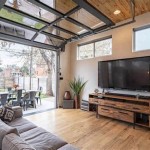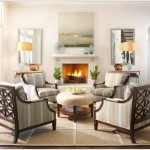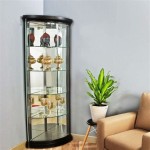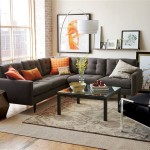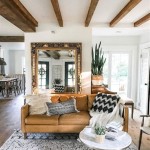Decorating Ideas for Rectangular Living Rooms
Rectangular living rooms, while common, can present unique decorating challenges. Their elongated shape can sometimes feel narrow or disproportionate, making furniture placement and overall flow difficult to optimize. However, with careful planning and a strategic approach, a rectangular living room can be transformed into a stylish and functional space. This article explores various decorating ideas and principles to maximize the potential of rectangular living rooms, addressing common issues and offering solutions for creating a balanced and inviting environment.
Before embarking on any decorating project, it's crucial to assess the room's dimensions and existing features. Measure the length and width of the room accurately. Note the location of windows, doors, fireplaces, and any built-in elements. Understanding these constraints will inform furniture selection, layout choices, and accessory placements. Consider the room's natural light. North-facing rooms tend to be cooler and may benefit from warmer color palettes and strategic lighting, while south-facing rooms can handle cooler tones and benefit from light-filtering window treatments. Also, contemplate the intended use of the room. Will it primarily be a space for relaxation, entertainment, or a combination of both? The function will heavily influence the type of furniture and accessories chosen.
Dividing the Space with Furniture Arrangement
One of the most effective ways to address the elongated nature of a rectangular living room is to divide the space into distinct zones using furniture arrangement. This breaks up the linearity of the room and creates visual interest. Instead of pushing all the furniture against the walls, consider creating a focal point in the center of the room with a rug and strategically placed seating. This encourages conversation and creates a more intimate atmosphere. Think of the room as a series of smaller, interconnected spaces rather than one long, continuous area.
One popular zoning strategy is to create a distinct seating area for conversation and relaxation. This can be accomplished by arranging a sofa, chairs, and coffee table around a focal point, such as a fireplace or a television. Another zone could be dedicated to reading, with a comfortable armchair, a floor lamp, and a small bookcase. A third zone might be a small dining area, particularly if the living room is open-plan. Defining these zones with area rugs can further enhance the separation and visually anchor each space.
When arranging furniture, avoid creating a bowling alley effect, where a clear pathway runs straight through the center of the room. This emphasizes the room's length and makes it feel less inviting. Instead, try to create staggered pathways that meander through the different zones. Consider using console tables or bookcases to create visual barriers that subtly guide movement through the space. Angling furniture pieces can also help to break up the linearity and create a more dynamic layout. For instance, placing a chair at an angle to the sofa can soften the overall impression and encourage interaction.
Scale is also a critical factor in furniture selection and arrangement. Avoid using excessively large or bulky furniture in a small rectangular room, as this will only accentuate the limited space. Opt for furniture that is appropriately sized for the room's dimensions. Consider using modular furniture, which can be easily rearranged to suit different needs and configurations. For instance, a sectional sofa can be broken down into smaller pieces to create more flexible seating arrangements. Similarly, nesting tables can be used to save space when not needed.
Utilizing Color and Pattern to Enhance Proportions
Color and pattern play a vital role in visually altering the proportions of a rectangular living room. Strategic use of color can make a long, narrow room appear wider or shorter, depending on the desired effect. Lighter colors tend to reflect light and create a sense of spaciousness, while darker colors can make a room feel cozier and more intimate. However, simply painting all the walls in a light color may not be enough to address the room's proportions. Consider using accent walls to create visual interest and break up the monotony of a long, narrow space.
Painting the shorter walls in a darker or brighter color than the longer walls can visually shorten the room. This draws the eye towards the ends of the room, making it feel wider. Conversely, painting the longer walls in a lighter color and the shorter walls in a darker color can visually lengthen the room. However, this approach should be used with caution, as it can further accentuate the room's elongated shape. Another option is to use a horizontal stripe pattern on the longer walls to visually widen the room. This creates the illusion of greater width and can make the room feel less constrained.
Pattern can also be used to add visual interest and break up the linearity of the room. Consider using patterned rugs, wallpaper, or fabrics to create focal points and define different zones. A large, bold pattern can anchor a seating area and draw the eye away from the room's length. However, be mindful of the scale of the pattern. A pattern that is too small can get lost in a large room, while a pattern that is too large can overwhelm a small room. Choose a pattern that is proportionate to the room's dimensions and complements the overall design scheme.
In addition to color and pattern, consider the impact of texture. Incorporating a variety of textures, such as plush rugs, woven throws, and smooth surfaces, can add depth and visual interest to the room. This can help to break up the monotony of a long, narrow space and create a more inviting atmosphere. For instance, a textured wall covering can add depth and dimension to a flat wall, while a plush rug can add warmth and comfort to a seating area.
Optimizing Lighting and Accessories for a Balanced Aesthetic
Lighting is crucial for creating a welcoming and functional living room. In a rectangular space, it’s particularly important to layer lighting from different sources to avoid shadows and ensure adequate illumination throughout the room. Relying solely on overhead lighting can create a harsh and unflattering effect. Instead, combine ambient lighting (such as recessed lights or chandeliers), task lighting (such as floor lamps or table lamps), and accent lighting (such as spotlights or sconces) to create a balanced and well-lit environment.
Place floor lamps strategically to illuminate dark corners and create a sense of spaciousness. Table lamps can be used to provide task lighting for reading or other activities. Accent lighting can be used to highlight artwork or architectural features. Consider using dimmers to adjust the intensity of the lighting and create different moods. In a rectangular room, it's particularly important to avoid creating shadows that emphasize the room's length. Position lighting fixtures to distribute light evenly throughout the space and minimize harsh contrasts.
Accessories play a vital role in adding personality and character to a living room. In a rectangular space, it's important to choose accessories that complement the room's proportions and enhance the overall design scheme. Avoid cluttering the room with too many small accessories, as this can make it feel cramped and disorganized. Instead, focus on a few carefully chosen pieces that make a statement. Large-scale artwork can add visual interest and create a focal point. Mirrors can be used to reflect light and create a sense of spaciousness. Plants can add a touch of nature and bring life to the room.
When arranging accessories, consider the principles of balance and symmetry. Avoid placing all the accessories on one side of the room, as this can create a sense of imbalance. Instead, distribute the accessories evenly throughout the space. Consider using groupings of objects to create visual interest. For instance, a collection of vases or candles can be arranged on a coffee table or mantel. Be mindful of the scale of the accessories. A large room can handle larger accessories, while a small room requires smaller accessories. Choosing the right accessories ensures that the rectangular living room feels curated and complete, achieving a balanced and aesthetically pleasing outcome.

How To Arrange Furniture In A Rectangular Living Room Design Cafe

Top Tips On How To Design Your Rectangular Living Room The House

How To Arrange Furniture In A Rectangular Living Room Design Cafe

Top Tips On How To Design Your Rectangular Living Room The House

How To Arrange Furniture Layout In A Rectangular Living Room

How To Arrange Furniture In A Rectangular Living Room Design Cafe

How To Plan A Rectangular Sitting Room With Example Floor Plans

How To Arrange Furniture In A Rectangular Living Room Design Cafe

How To Arrange Furniture In A Rectangular Living Room Design Cafe

How To Decorate A Long Or Narrow Living Room Solutions For Tricky Spaces

